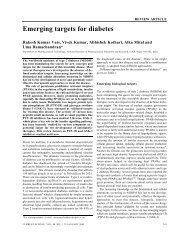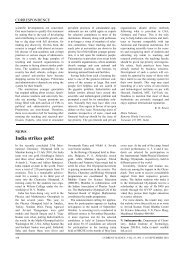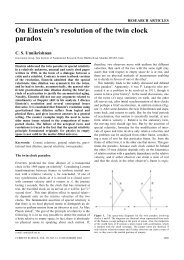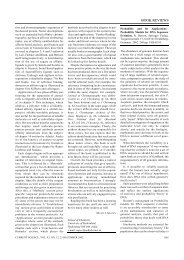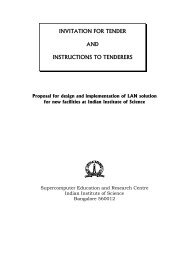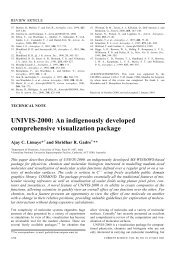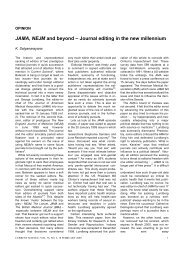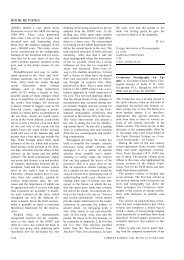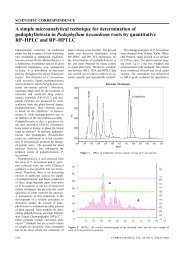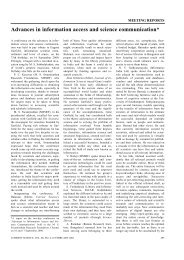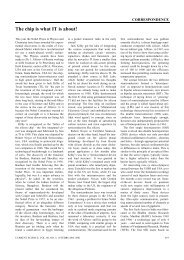Crystal structure of nickel-reconstituted haemoglobin â A case for ...
Crystal structure of nickel-reconstituted haemoglobin â A case for ...
Crystal structure of nickel-reconstituted haemoglobin â A case for ...
You also want an ePaper? Increase the reach of your titles
YUMPU automatically turns print PDFs into web optimized ePapers that Google loves.
<strong>Crystal</strong> <strong>structure</strong> <strong>of</strong> <strong>nickel</strong>-<strong>reconstituted</strong><br />
<strong>haemoglobin</strong> – A <strong>case</strong> <strong>for</strong> permanent T-state<br />
<strong>haemoglobin</strong><br />
RESEARCH ARTICLES<br />
Swarnalatha Venkateshrao † , S. Deepthi # , V. Pattabhi # and P. T. Manoharan †, * ,§<br />
† Department <strong>of</strong> Chemistry and Regional Sophisticated Instrumentation Centre, Indian Institute <strong>of</strong> Technology – Madras, Chennai 600 036, India<br />
# Department <strong>of</strong> <strong>Crystal</strong>lography and Biophysics, University <strong>of</strong> Madras, Chennai 600 025, India<br />
§ Jawaharlal Nehru Centre <strong>for</strong> Advanced Scientific Research, Jakkur, Bangalore 560 064, India<br />
The three-dimensional crystal <strong>structure</strong> <strong>of</strong> <strong>nickel</strong>-re<br />
constituted human <strong>haemoglobin</strong> (NiHb) is determined<br />
by X-ray crystallography at 2.5 Å resolution. The<br />
final refined model, when compared with deoxy <strong>haemoglobin</strong>,<br />
clearly reveals a permanent T-state con<strong>for</strong>mation<br />
<strong>of</strong> NiHb. The tertiary changes associated<br />
with the alpha subunit are larger in magnitude than<br />
those in beta subunits. However, there are some significant<br />
quaternary changes observed at the interfacial<br />
regions arising out <strong>of</strong> the perturbations associated<br />
with the Ni haeme in the alpha subunit. The central<br />
metal ion in the two alpha subunits and one <strong>of</strong> the<br />
beta subunits is clearly four-coordinated, while the<br />
other beta subunit reveals a greater tendency <strong>for</strong> the<br />
metal ion to be five-coordinated at the heme site. This<br />
result is consistent with the earlier findings like optical,<br />
resonance Raman, NMR, and spin-labelled EPR<br />
studies on NiHb, which show two different metal ion<br />
environments in NiHb, interpreted as due to four and<br />
five-coordination. Hence it is clear that there is inequivalence<br />
between the two beta subunits in addition<br />
to the heterogeneity observed among the alpha and<br />
beta subunits. <strong>Crystal</strong>lographic evidence revealing the<br />
presence <strong>of</strong> a five-coordinated <strong>nickel</strong>(II) porphyrin<br />
complex is a special feature <strong>of</strong> interest presented here.<br />
COOPERATIVE ligand binding in <strong>haemoglobin</strong> (Hb) has<br />
been a subject <strong>of</strong> immense interest over the past few decades<br />
1–3 . Several theories were put <strong>for</strong>th in order to explain<br />
the origin <strong>of</strong> such cooperativity 4–8 (MWC model 4 ,<br />
Pauling model 5 , KNF model 6 , Perutz’s ‘triggering mechanism’<br />
7 and the Acker’s symmetry rules 8 ). The stereochemical<br />
mechanism proposed by Perutz is based on the<br />
X-ray <strong>structure</strong>s <strong>of</strong> two alternate <strong>structure</strong>s, the deoxyHb<br />
designated as the T- (tensed) state and the oxy R-<br />
(relaxed) state. In order to understand the molecular<br />
mechanism <strong>of</strong> cooperative ligand binding in heme proteins,<br />
it is necessary to investigate in detail the <strong>structure</strong>s<br />
<strong>of</strong> fully unligated and ligated molecules and compare the<br />
structural changes with those <strong>of</strong> the intermediate species<br />
*For correspondence. (e-mail: ptm@rsic.iitm.ernet.in)<br />
associated in the T ↔ R transition. The central metal ion<br />
in heme proteins is recognized as the principal site <strong>of</strong><br />
interaction and hence plays an important role in elucidating<br />
the <strong>structure</strong>–function relationship. The reconstitution<br />
experiments in which the central metal atom<br />
Fe(II) is replaced by similar transition metals such as<br />
Ni(II), Cu(II), Co(II), Mg(II), Mn(II), Zn(II) have proved<br />
useful in providing a good deal <strong>of</strong> in<strong>for</strong>mation on the<br />
electronic and spin states <strong>of</strong> the metal ion which are<br />
responsible <strong>for</strong> the global con<strong>for</strong>mation <strong>of</strong> the molecule 9 .<br />
The primary approach <strong>for</strong> a better understanding <strong>of</strong> the<br />
<strong>structure</strong>–function relationship at the atomic level is<br />
obtained from the X-ray <strong>structure</strong> <strong>of</strong> the protein species<br />
involved. <strong>Crystal</strong>s <strong>of</strong> <strong>reconstituted</strong> MgHb 10 , MnHb 11 ,<br />
CoHb 12 and hybrid Hbs such as Fe–Co 13 , Ni-Fe 14 , Fe-<br />
Ni 15 , Mg-Fe 16 , Fe-Mn 17 have been studied by X-ray<br />
<strong>structure</strong> analysis. Spectroscopic, physical and chemical<br />
studies on these <strong>reconstituted</strong> heme proteins have provided<br />
certain interesting features over the past few years<br />
which have led to a better investigation on the structural<br />
and chemical basis <strong>of</strong> heme–heme interaction.<br />
Metal ions such as Cu(II), Ni(II) 18–20 and Mg(II) 16 have<br />
been considered as good reporter groups <strong>for</strong> stabilizing a<br />
T-state con<strong>for</strong>mation <strong>of</strong> the molecule. In particular,<br />
Cu(II) and Ni(II) do not bind either CO or O 2 , and hence<br />
they are regarded as very stable species representing a<br />
permanent deoxy T-state molecule, as also suggested on<br />
the basis <strong>of</strong> chemical reactivity studies using 4,4′-pyridine<br />
disulphide (PDS) 19 . Oxygen-binding studies on Ni–<br />
Fe hybrids have proved that Ni(II) protoporphyrin IX is a<br />
suitable model <strong>for</strong> a permanent deoxy heme 20 . The most<br />
interesting feature in <strong>case</strong> <strong>of</strong> NiHb is the presence <strong>of</strong> two<br />
different metal ion sites, a four-coordination and a fivecoordination<br />
as revealed by earlier spectroscopic studies<br />
18,19,21–23 . The fifth coordination is satisfied by the N(ε)<br />
<strong>of</strong> the proximal histidine <strong>of</strong> the protein chain, which is<br />
unique in <strong>case</strong> <strong>of</strong> the <strong>nickel</strong> porphyrins. We report here a<br />
detailed analysis <strong>of</strong> the crystal <strong>structure</strong> <strong>of</strong> NiHb and its<br />
comparison with deoxyHb. This work was particularly<br />
chosen in order to investigate the similarities and differences<br />
between NiHb and deoxyHb, both being T-state<br />
CURRENT SCIENCE, VOL. 84, NO. 2, 25 JANUARY 2003 179
RESEARCH ARTICLES<br />
molecules. It is also <strong>of</strong> interest to investigate the presence<br />
<strong>of</strong> two different metal ion sites existing in the same molecule.<br />
Materials and methods<br />
<strong>Crystal</strong>lization, data collection and processing<br />
Human Hb was first separated from RBC, and purified<br />
further by well-established methods 24 . Reconstituted<br />
Ni(II) Hb was prepared and purified as described earlier<br />
23 . <strong>Crystal</strong>s were grown in batch method from a 15%<br />
(w/v) polyethylene glycol-8000 and a 4% Hb solution at<br />
room temperature <strong>for</strong> 10–14 days. The X-ray data were<br />
obtained (Table 1) using the Mar Research Image plate<br />
system, processed and scaled using Mar XDS at the<br />
Molecular Biophysics Unit, Indian Institute <strong>of</strong> Science,<br />
Bangalore. The crystal-to-detector distance was 100 mm.<br />
The intensity data were collected <strong>for</strong> every 1° rotation in<br />
the phi axis and the exposure time was maintained at<br />
300 s per frame. A total <strong>of</strong> 111 frames corresponding to<br />
90° rotation in the phi axis were collected. The crystals<br />
diffracted to a resolution <strong>of</strong> 2.5 Å, and belong to the<br />
space group P2 1 2 1 2 with cell parameters: a = 95.2 Å,<br />
b = 96.3 Å, c = 65.2 Å. The data were processed and<br />
scaled using MAR XDS.<br />
Structure solution and refinement<br />
The <strong>structure</strong> was solved by the molecular replacement<br />
method using X-PLOR 25 , with the partially oxygenated<br />
T-state human Hb 26 as the search model. A non-crystallographic<br />
symmetry along the psuedo dyad axis was assumed<br />
throughout the refinement. A consistent solution at<br />
θ 1 = 0, θ 2 = 0 and θ 3 = 0, and a translation at δx = 0,<br />
δy = 0.25, δz = 0, appeared in five different resolution<br />
ranges. The rigid body refinement led to a R-factor <strong>of</strong><br />
0.38 and R-free = 0.41, with a 2σ cut-<strong>of</strong>f at a resolution<br />
range <strong>of</strong> 8.0–2.5 Å. Subsequently, a few cycles <strong>of</strong> positional<br />
refinement resulted in a R-factor <strong>of</strong> 29% and R-free<br />
<strong>of</strong> 39%. The <strong>structure</strong> was further refined and the model<br />
corrected using 2F o –F c and F o –F c maps employing the<br />
program ‘O’. Thirty-eight water molecules were located<br />
and further refinement gave a R-factor <strong>of</strong> 24.2% and R-<br />
180<br />
Table 1. Output summary <strong>of</strong> X-ray data collection<br />
Minimum and maximum resolution (Å): 19.8, 2.5<br />
Number <strong>of</strong> observations in input : 75819<br />
Number <strong>of</strong> reflections with i = 0 : 15810<br />
Number <strong>of</strong> rejected reflections : 0<br />
Number <strong>of</strong> anomalous differences : 15959<br />
Number <strong>of</strong> unique reflections in output : 19946<br />
Multiplicity <strong>of</strong> data set : 3.8<br />
Completeness <strong>of</strong> data set : 91.4%<br />
R-factor on intensities : 15.5%<br />
free = 32.4%. The final refinement parameters are listed<br />
in Table 2. The final refined coordinates have been deposited<br />
in the Brookhaven Data Bank (PDB ID 1FN3).<br />
Results<br />
Reference frames<br />
To examine the structural differences between deoxyHb<br />
and NiHb <strong>structure</strong>s, we have chosen three principle reference<br />
frames: (i) Baldwin and Chothia 27 used the α 1 β 1<br />
interface as a reference frame <strong>for</strong> comparing the T and R<br />
states <strong>of</strong> the molecule. This comprises largely parts <strong>of</strong> the<br />
B, G and H helices <strong>of</strong> both chains. We have adopted here<br />
<strong>for</strong> α residues B 20–36, G 98–112 and H 118–134; <strong>for</strong> β<br />
residues B 20–33, G 104–116 and H 125–139 as the ‘BGH<br />
reference frame’. (ii) ‘F-helix frame’ which illustrates the<br />
extent <strong>of</strong> con<strong>for</strong>mational change at the F-helix, FG-corner<br />
and heme. (iii) ‘Heme frame’ which illustrates the differences<br />
in the coordination sphere <strong>of</strong> the central metal ion.<br />
Comparison <strong>of</strong> deoxyHb and NiHb <strong>structure</strong>s<br />
When the <strong>structure</strong> <strong>of</strong> NiHb is superimposed on deoxy-<br />
Hb 28 , the rms difference is found to be 0.8 Å <strong>for</strong> all mainchain<br />
atoms. The rms difference <strong>for</strong> all the backbone<br />
atoms at the α 1 β 1 interface <strong>for</strong> the two <strong>structure</strong>s is 0.6 Å,<br />
suggesting that there is no significant structural difference<br />
occurring at this interface.<br />
Tertiary structural changes in the α-subunit<br />
The rms difference <strong>for</strong> all the main-chain atoms at the<br />
BGH reference frame is 0.7 Å <strong>for</strong> both α 1 and α 2 . When<br />
the heme groups are superimposed (Figure 1 a), significant<br />
shifts in E- and F-helices are observed in both the α-<br />
subunits. The residue vs rms deviation <strong>for</strong> the superposition<br />
<strong>of</strong> α 1 chains <strong>of</strong> NiHb over deoxyHb molecule is<br />
shown in Figure 1 b, specially to clearly see the shift in<br />
the E-helix. The E-helix has moved in a direction perpendicular<br />
to the helical axis, and away from the heme.<br />
This movement <strong>of</strong> the E-helix is further continued in<br />
such a way that the F-helix is significantly moved out,<br />
thereby pulling the proximal histidine away from the<br />
heme pocket. Figure 1 a indicates a significant shift in the<br />
main-chain con<strong>for</strong>mation <strong>of</strong> the F-helix residues, which<br />
is propagated till the beginning <strong>of</strong> the FG-corner. The<br />
rms difference <strong>for</strong> the main-chain atoms at the FG-corner<br />
is 1.1 Å <strong>for</strong> α 1 and 1.0 Å <strong>for</strong> α 2 . The main-chain con<strong>for</strong>mation<br />
at the FG-corner is almost retained in both<br />
NiHb and deoxyHb, whereas marked changes occur at<br />
the region FG1–FG4. There is a significant movement <strong>of</strong><br />
the FG-corner across the heme plane. Not much change is<br />
observed in the main-chain residues <strong>of</strong> the CD-region,<br />
CURRENT SCIENCE, VOL. 84, NO. 2, 25 JANUARY 2003
RESEARCH ARTICLES<br />
Figure 1 a. Stereo figure <strong>of</strong> α 1 heme pocket <strong>of</strong> deoxy T-state Hb (grey lines) and NiHb (dark lines).<br />
Structures were superimposed by least squares fitting <strong>of</strong> atoms <strong>of</strong> the heme group. Movement <strong>of</strong> the<br />
E- and F-helices away from the heme is evident.<br />
Rms<br />
4.5<br />
4<br />
3.5<br />
3<br />
2.5<br />
2<br />
1.5<br />
1<br />
0.5<br />
0<br />
0 10 20 30 40 50 60 70 80 90 100 110 120 130 140 150<br />
Residue<br />
Figure 1 b. Residue vs rms <strong>for</strong> the superposition <strong>of</strong> α 1 chains <strong>of</strong> NiHb<br />
over deoxyHb molecule (black and gray lines show the superposition<br />
<strong>of</strong> main chain and side chain respectively).<br />
while the side chains <strong>of</strong> PheCD4, PheCD1 and TyrC7<br />
undergo slight changes in con<strong>for</strong>mation to adapt their<br />
positions with respect to the movement <strong>of</strong> the E and F<br />
helices. The C-terminal residues Tyr140 (HC2) and Arg141<br />
(HC3) have significant electron density and hence they are<br />
localized as in the <strong>case</strong> <strong>of</strong> deoxyHb. Thus the changes<br />
associated with α 1 and α 2 are almost the same.<br />
Tertiary structural changes in the β-subunit<br />
The rms deviation <strong>of</strong> the main-chain atoms at the BGH<br />
frame <strong>of</strong> reference <strong>for</strong> both β 1 and β 2 is 0.6 Å. Superposition<br />
<strong>of</strong> the heme frames in the β 1 subunit indicates a<br />
shift in the E-helix in a direction parallel to the helical<br />
axis. The F-helix has moved in a direction perpendicular<br />
to the helical axis, away from the heme plane. At β 2 , the<br />
shift <strong>of</strong> the E-helix is significant and continues till the<br />
beginning <strong>of</strong> the F-helix. Unlike in β 1 , the F-helix is<br />
moved slightly towards the heme pocket, whereas<br />
movement <strong>of</strong> the E-helix occurs in a direction away from<br />
the heme group as seen in Figure 2 a. The rms difference<br />
<strong>of</strong> the main-chain atoms at the FG-corner is relatively<br />
much lower (0.4 Å in both β 1 and β 2 subunits) when<br />
compared to the α-subunits. Also, the main-chain con<strong>for</strong>mation<br />
is the same at the FG-corner, except that the<br />
FG-corner is moved as a whole and this movement is<br />
propagated towards the beginning <strong>of</strong> the G-helix.<br />
The sulphydryl group <strong>of</strong> the β93 cysteine residue in<br />
both the β-subunits, which is adjacent to the proximal<br />
histidine, retains its con<strong>for</strong>mation similar to that <strong>of</strong><br />
deoxyHb and varies with that <strong>of</strong> carbonmonoxyHb (Figure<br />
3). The position <strong>of</strong> the C-terminal (β146) histidine is<br />
such that the side chain makes a salt bridge with the Asp<br />
(FG1) 94 which is known to be a prominent interaction<br />
<strong>for</strong> a T-state con<strong>for</strong>mation. Here again, we observe that<br />
the C-terminal residues which are β145 tyrosine and<br />
β146 histidine have significant electron density in β 1<br />
compared to β 2 (Figure 4) and are localized, thereby<br />
shielding the sulphydryl pocket <strong>of</strong> the cysteine residue.<br />
Heme environment<br />
It is clear from the Ni–N(ε) distances (Table 3) that at<br />
both the α-subunits, the M–N(ε) bond is broken thereby<br />
stabilizing a stable four-coordinated Ni-heme. In <strong>case</strong> <strong>of</strong><br />
β 1 , though the Ni-heme is again four-coordinated, Ni–<br />
N(ε) distance is considerably shortened compared to<br />
those in the α-subunits, whereas in <strong>case</strong> <strong>of</strong> β 2 , the Ni–<br />
N(ε) distance is relatively much less compared to the α-<br />
subunits, thereby indicating a fifth coordination <strong>of</strong> proximal<br />
histidine with the metal centre. Inspection <strong>of</strong> the<br />
2F o –F c density map clearly shows the Ni-heme electron<br />
density being pulled towards the proximal histidine (F8)<br />
(Figure 5). This closeness <strong>of</strong> density at β 2 reveals the fact<br />
that the β 2 -subunit tends to prefer a five-coordinated<br />
geometry.<br />
The heme plane in both the α-subunits as well as in β 1<br />
are parallel to the F-helical axis, and is well shifted towards<br />
the heme pocket with respect to the F-helix frame.<br />
CURRENT SCIENCE, VOL. 84, NO. 2, 25 JANUARY 2003 181
RESEARCH ARTICLES<br />
a<br />
b<br />
Figure 2. Stereo figure <strong>of</strong> the β 2 heme pocket <strong>of</strong> deoxy T-state Hb (grey lines) and NiHb (dark lines).<br />
a, Structures were superimposed by least squares fitting <strong>of</strong> atoms <strong>of</strong> the heme moiety. Marked movement<br />
<strong>of</strong> the F-helix is evident in NiHb; b, Structures were superimposed by least squares fitting <strong>of</strong> main-chain<br />
atoms <strong>of</strong> F4–F8. Movement and tilt <strong>of</strong> heme towards the F-helix is evident.<br />
Figure 3. Sulphydryl pocket at β 2-subunit <strong>of</strong> deoxyHb, NiHb and carbonmonoxyHb.<br />
At the β 2 subunit, the heme group still retains to be parallel<br />
to the F-helix, but with a simultaneous tilt <strong>of</strong> the<br />
182<br />
plane <strong>of</strong> porphyrin, thereby facilitating a coordination<br />
with the metal centre (Figure 2 b).<br />
CURRENT SCIENCE, VOL. 84, NO. 2, 25 JANUARY 2003
RESEARCH ARTICLES<br />
β 1 β 2<br />
Figure 4. 2F o–F c electron density map at the C-terminal regions <strong>of</strong> β 1 and β 2-subunits. Insufficient<br />
electron density at the His146 (HC3) at β 2 compared to β 1 is clearly consistent with the<br />
two different sulphydryl pockets arising from difference in the metal ion environment between<br />
the two β-subunits.<br />
Table 2. Final refinement parameters<br />
Resolution range (Å) : 8.0–2.5<br />
R-factor : 0.242<br />
R-free : 0.324<br />
Water molecules : 38<br />
Ramachandran outliers : None<br />
Rms deviation from ideal geometry<br />
Bond length (Å) : 0.017<br />
Bond angle (°) : 2.241<br />
Torsion angle (°) : 27.059<br />
Improper angle (°) : 1.627<br />
Quaternary structural changes<br />
Table 4 shows the various subunit interactions which<br />
stabilize a deoxy T-state con<strong>for</strong>mation. The interface<br />
between α 1 β 1 and α 2 β 2 is <strong>for</strong>med by contacts between α 1<br />
and β 2 , and the dyad-related contacts between α 2 and β 1 .<br />
The side chains <strong>of</strong> Hisβ 2 97 (FG4) packs between<br />
Thrα 1 41 (C6) and Proα 1 44 (CD2) (Figure 6). The side<br />
chain <strong>of</strong> Aspβ 2 (G1) <strong>for</strong>ms a hydrogen bond to O(ε) <strong>of</strong><br />
Tyrα 1 42 (C7), which is similar to that <strong>of</strong> deoxyHb. The<br />
N(δ) <strong>of</strong> Asnα 1 97 (G4) <strong>for</strong>ms a hydrogen bond with O(δ)<br />
<strong>of</strong> Aspβ 2 99 (G1). The amino group <strong>of</strong> Argα 1 92 is in contact<br />
with the carbonyl oxygen <strong>of</strong> Proβ 2 36 and the O(δ 1 )94<br />
Asp <strong>of</strong> α 1 -subunit is in contact with O(δ 2 ) <strong>of</strong> Aspβ 1 99<br />
(G1). The carbonyl group <strong>of</strong> Argα 1 141 is salt-bridged to<br />
the amino group at the opposite α-chain, i.e. Lysα 2 127,<br />
which is similar to the one observed in deoxyHb.<br />
Discussion<br />
Evidence <strong>for</strong> mixed metal ion coordination<br />
It is well known that NiHb possesses a mixture <strong>of</strong> both<br />
four- and five-coordinated <strong>for</strong>ms 18,19,21–23 . This interesting<br />
feature <strong>of</strong> two different metal ion sites is strongly<br />
modulated by the protein <strong>structure</strong>, which encapsulates<br />
the heme core. The present finding indicates that the structural<br />
changes at the α-subunit are larger in magnitude<br />
than those at the β-subunits. These changes occur mainly<br />
at the FG-corner, E- and F-helices. It is clear from Figure<br />
1 that Ni (II), being a low-spin d 8 ion, tends to favour a<br />
four-coordinated geometry without any axial ligand. This<br />
has induced a shift in E- and F-helices to move away<br />
from the heme in the α-subunits, thereby facilitating the<br />
molecule to retain a deoxy con<strong>for</strong>mation. An interesting<br />
feature emerges when we compare the metal ion coordination<br />
in the hemes <strong>of</strong> NiHb with those <strong>of</strong> α 2 (FeO 2 )β 2<br />
(Ni) 13 and α 2 (Ni)β 2 (FeCO)Hb 14 . While the latter two<br />
species tend towards the R-state, the <strong>for</strong>mer is rigorously<br />
in the T-state. In α 2 (FeO 2 )β 2 (Ni), both the β-hemes are<br />
CURRENT SCIENCE, VOL. 84, NO. 2, 25 JANUARY 2003 183
RESEARCH ARTICLES<br />
α 1<br />
β 1<br />
α 2<br />
β 2<br />
Figure 5. 2F o–F c density map sectioned into the heme <strong>for</strong> clarity, with the proximal and distal<br />
histidines. The map is contoured at 1σ. With exception at the β 2 heme, the ligand and heme density is<br />
clearly consistent with a fully four-coordinated Ni metal.<br />
184<br />
Table 3. Distance <strong>of</strong> the proximal and distal histidines<br />
to the metal<br />
Ni–N(ε) proximal Ni–N(ε) distal<br />
Subunit histidine (Å) histidine (Å)<br />
α 1 3.90 4.52<br />
α 2 4.10 4.91<br />
β 1 3.26 4.24<br />
β 2 3.07 4.40<br />
penta-coordinated, as proven by both crystallography 13<br />
and spectroscopy 22 . However, in the <strong>case</strong> <strong>of</strong> α 2 (Ni)β 2<br />
(FeCO), the Ni–N(ε) bond is broken despite the fact that<br />
this hybrid tends towards the R-state. Hence it is not<br />
surprising that NiHb, an example <strong>of</strong> extreme T-state as<br />
proven by spectroscopy and chemical studies (e.g. PDS<br />
reactivity pr<strong>of</strong>ile 19 ), has purely four-coordinated α-hemes<br />
and a partially five-coordinated β-heme. This indicates<br />
that R → T con<strong>for</strong>mational change in these three proteins<br />
not only breaks the Ni–N(ε) bond in the α-subunit, but<br />
also weakens the same in the β-subunit.<br />
Comparison with other spectroscopic results<br />
Optical and chemical studies 23 show the subunits in NiHb<br />
to be in the deoxy or T-<strong>structure</strong>. UV–visible 18,19 absorption<br />
spectra revealed a split soret band characteristic <strong>of</strong><br />
two different metal ion environments in NiHb. Later in<br />
1986, Shelnutt et al. 21 investigated the state <strong>of</strong> coordination<br />
<strong>of</strong> Ni (II) in NiHb, NiMb and a variety <strong>of</strong> model Ni<br />
porphyrins (NiPPs). The Raman results are consistent<br />
with two metal ion sites as also proposed <strong>for</strong> CuHb 18 , one<br />
being a four-coordinate <strong>for</strong>m and the other being a fivecoordinate<br />
<strong>for</strong>m. Further evidence <strong>for</strong> a five-coordinate<br />
CURRENT SCIENCE, VOL. 84, NO. 2, 25 JANUARY 2003
RESEARCH ARTICLES<br />
Figure 6. Stereoscopic view <strong>of</strong> α 1–β 2 interface: Packing <strong>of</strong> C-helix <strong>of</strong> α 1 and FG-corner <strong>of</strong> β 2 is<br />
shown in dark lines <strong>for</strong> NiHb and in grey lines <strong>for</strong> deoxyHb.<br />
Table 4. Interaction between subunits at interfacial regions<br />
α 1-subunit β 2-subunit Distance (Å)<br />
Residue Atom Residue Atom NiHb DeoxyHb<br />
Lys 40 C5(N ζ ) His 146 HC3(O ε ) 3.81 3.16<br />
Tyr 42 C7(OH) Asp 99 G1(O δ ) 2.61 2.49<br />
Asp 94 G1(O δ ) Trp 37 C7( N ε ) 3.85 2.84<br />
Asn 97 G4(N δ ) Asp 99 G1(O δ ) 3.28 2.99<br />
Arg 141 HC3(N η ) Val 34 B16(O) 4.6 2.86<br />
I. Stabilizing interactions within subunits<br />
Tyr 145βOH … OC Val 98β 2.22 2.56<br />
His 146 β Im + … – OOC Asp 94β 2.88 2.58<br />
II. Stabilizing interactions between subunits<br />
Lys 127α 1N ζ … OC Arg 141α 2 2.95 2.74<br />
Asp 126α 1COO – … + Gua Arg 141α 2 3.35 3.01<br />
Tyr 42α 1OH … – OOC Asp 99β 2 2.61 2.49<br />
Ni(II) comes from proton nuclear magnetic resonance<br />
studies 22 <strong>of</strong> Ni-<strong>reconstituted</strong> heme proteins. The presence<br />
or absence <strong>of</strong> hyperfine-shifted proximal histydyl N δ H<br />
exchangeable proton resonances provides in<strong>for</strong>mation on<br />
the coordination and spin states <strong>of</strong> NiPP in each subunit.<br />
The hyperfine-shifted resonances at about 70.5 ppm were<br />
observed <strong>for</strong> NiHb and α(Fe) 2 β(Ni) 2 but not <strong>for</strong> α(Ni) 2 β<br />
(Fe) 2 . Shibayama et al. 22 suggested that this could arise<br />
only when the Ni (II) assumes a high-spin (S = 1), fivecoordinated<br />
<strong>for</strong>m which is due to the proximal histidine<br />
serving as an axial ligand. Observation <strong>of</strong> temperaturedependent,<br />
broad, non-exchangeable, hydrogen-bonded<br />
proton resonances (12.6 and 10.9 ppm) and ring currentshifted<br />
broad resonances around – 2 ppm in NiHb and<br />
α 2 (Fe–CO)β 2 (Ni) alone further substantiates the fact that<br />
NiPP is paramagnetic and five-coordinated in the β-<br />
subunit. It is significant to note that such a paramagnetic<br />
shift is not seen <strong>for</strong> the α-subunit (α 2 (Ni)β 2 (Fe)), indicating<br />
its S = 0 state due to the detachment <strong>of</strong> Ni–N(ε)<br />
bond. EPR studies on spin-labelled NiHb 19 revealed two<br />
different spin-label environments as a result <strong>of</strong> different<br />
protein con<strong>for</strong>mations in the same molecule.<br />
In agreement with the a<strong>for</strong>esaid spectroscopic conclusions,<br />
our crystallographic findings reveal that the β 2 -<br />
subunit tends to be five-coordinated, while both the<br />
α-subunits and the β 1 -subunit remain four-coordinated in<br />
the most T-<strong>structure</strong>d NiHb. This is clear from a closer<br />
inspection <strong>of</strong> the 2F o –F c electron density <strong>of</strong> the heme<br />
region in all four subunits (Figure 5). Movement <strong>of</strong> the F-<br />
helix is such that there is a simultaneous tilt and displacement<br />
<strong>of</strong> the imidazole ring towards the heme pocket<br />
(Figure 2 a). Although the Ni–N(ε) proximal histidine<br />
distance seems to be slightly higher than that <strong>of</strong> a bonding<br />
distance (Table 3), closeness <strong>of</strong> the electron density<br />
<strong>of</strong> histidine near the heme is indicative <strong>of</strong> a preferential<br />
five-coordination <strong>of</strong> the Ni (II) in β 2 . Similarly, the elec-<br />
CURRENT SCIENCE, VOL. 84, NO. 2, 25 JANUARY 2003 185
RESEARCH ARTICLES<br />
tron density <strong>of</strong> histidine in β 1 is far closer to those in the<br />
α-subunit, though a little far-<strong>of</strong>f compared to the β 2 -subunit.<br />
It is important to point out that Shelnutt et al. 21<br />
observed (i) a low value <strong>for</strong> Ni–N(ε) stretching frequency<br />
at 236 cm –1 in NiHb, indicating a weak five-coordination,<br />
and (ii) only a decrease <strong>of</strong> almost 7 cm –1 in the Ni–ligand<br />
stretch in NiHb, upon 64 Ni-isotopic substitution, against a<br />
prediction <strong>of</strong> 10 cm –1 <strong>for</strong> a pure Ni–ligand stretch as in<br />
the <strong>case</strong> <strong>for</strong> NiMb. Thus, our studies strongly suggest<br />
that the weak five-coordination is reflected more in the<br />
β 2 than in the β 1 -subunit, which is again reflected in the<br />
C-terminal regions (Figure 4).<br />
However, at a resolution <strong>of</strong> 2.5 Å, an error <strong>of</strong> 0.2 Å is<br />
most likely in atomic coordinates; this would mean that Ni–<br />
N(ε) (proximal) bonds can be 3.1–3.3 Å in both the β-subunits,<br />
prompting us to suggest equivalence <strong>of</strong> β 1 and<br />
β 2 -subunits in the heme area, with a five-coordinate being<br />
described as four from basal porphyrin and a weak interaction<br />
with a more distant proximal histidine. A comment<br />
is needed on this fifth weak coordination at a distance <strong>of</strong><br />
~ 3.1 Å. Such a kind <strong>of</strong> long-distance coordination<br />
(~ 3.0 Å) has been substantiated earlier by Solomon and<br />
coworkers 29 in the <strong>case</strong> <strong>of</strong> blue copper proteins.<br />
Structural changes at the α 1 –β 2 interface<br />
Baldwin and Chothia 27 have explored in detail the quaternary<br />
changes associated with tertiary structural<br />
changes during T ↔ R transition. The α 1 –β 1 dimer <strong>for</strong>ms<br />
several contacts with the α 2 –β 2 dimer, which serves as a<br />
signal-transmitting pathway between subunits on ligand<br />
binding. It is observed from our finding that the residues<br />
in contact between α 1 C and β 2 FG which is considered as<br />
the ‘switch region’ are still retained in NiHb (Figure 6),<br />
similar to that <strong>of</strong> deoxyHb. Whereas more dramatic<br />
changes occur at the α 1 FG–β 2 C core, which is considered<br />
as the ‘Flexible region’. It has been previously noted by<br />
Max Perutz 23 , on the basis <strong>of</strong> preliminary X-ray study on<br />
NiHb, that although NiHb, assumes a T-state con<strong>for</strong>mation<br />
there exists certain significant structural changes<br />
with respect to deoxyHb. It is now clear from our present<br />
structural analysis on NiHb, that the significant structural<br />
changes are due to the four-coordinated Ni-heme at the<br />
α-subunit which has induced certain structural perturbations<br />
in the heme pocket, F-helix and FG-corner. It is to<br />
be noted in this context that a four-coordinated metal<br />
porphyrin, which is less constrained inside the hydrophobic<br />
globin pocket, is likely to enjoy a greater vibrational<br />
freedom. We believe from our present investigation that<br />
this small but significant delocalization <strong>of</strong> the four-coordinated<br />
Ni-heme mainly in the α-subunit has induced the<br />
proximal F8 histidine to move away from the heme moiety<br />
which has influenced the structural perturbation at the<br />
Valα93(FG5), as also observed by Ho 30 <strong>for</strong> con<strong>for</strong>mational<br />
changes between T and R states. This perturbation<br />
186<br />
is transmitted to Tyrα140(HC2) and then across the interface<br />
to Trpβ37(C3) and then Argβ40(C6) (by way <strong>of</strong><br />
Thrβ38(C4) and Glnβ39(C5)), Tyrα42(C7), Aspβ99(G1)<br />
and Valβ98(FG5), and finally to the β-heme. This is illustrated<br />
in Scheme 1. Thus heme–heme interaction is<br />
likely to operate synchronously to transmit con<strong>for</strong>mational<br />
changes from one subunit to the neighbouring subunit.<br />
Role <strong>of</strong> β93 Cys<br />
The sulphydryl group <strong>of</strong> β93 Cys residue is well documented<br />
as a reporter group <strong>for</strong> monitoring the con<strong>for</strong>mational<br />
changes occurring in the molecule 31,32 . Figure 3<br />
illustrates that in <strong>case</strong> <strong>of</strong> NiHb, the SH-group retains the<br />
same con<strong>for</strong>mation as in the <strong>case</strong> <strong>of</strong> the deoxy <strong>structure</strong>.<br />
The presence <strong>of</strong> a strong hydrogen bond between the Asp<br />
FG1 and the side chain <strong>of</strong> histidine reveals the fact that<br />
the SH-group <strong>of</strong> β93 Cys is further hindered in <strong>case</strong> <strong>of</strong> a<br />
T-state molecule. This is in accordance with the previous<br />
studies on the very low reactivity <strong>of</strong> the SH-group <strong>of</strong> β93<br />
Cys towards PDS in <strong>case</strong> <strong>of</strong> NiHb 18 . In spite <strong>of</strong> the same<br />
con<strong>for</strong>mation being retained in both β 1 and β 2 -subunits,<br />
the appearance <strong>of</strong> significant electron density only in the<br />
C-terminal histidine <strong>of</strong> β 1 -subunit indicates the inequivalent<br />
flexibility <strong>of</strong> the terminal histidine between the<br />
two β-subunits (Figure 4). Thus, it is convincing from<br />
this study that the two slightly differing metal-ion environments<br />
<strong>of</strong> the β-subunits have in turn resulted in different<br />
sulphydryl pockets which is in exact agreement<br />
with the earlier reported EPR studies on spin-labelled<br />
NiHbs 31 . It may be noted that Manoharan and coworkers<br />
31 observed two different immobile components, as<br />
seen from different 2T || values, in NiHb when the β93 SH<br />
group was attached with longer spin labels.<br />
α-heme<br />
Aspβ99(G1)<br />
His (F8)α87<br />
Tyrα42(C7)<br />
Valβ98(FG5)<br />
β-heme<br />
Thrα41(C6)<br />
Tyrβ145(HC2)<br />
Valα93(FG5)<br />
Argβ40(C6)<br />
Scheme 1. Con<strong>for</strong>mational changes.<br />
Tryα140(HC2)<br />
Trpβ37(C3)<br />
CURRENT SCIENCE, VOL. 84, NO. 2, 25 JANUARY 2003
RESEARCH ARTICLES<br />
Conclusion<br />
Our present crystallographic studies on NiHb confirm<br />
that it takes up a <strong>structure</strong> similar to that <strong>of</strong> deoxyHb.<br />
The unique feature <strong>of</strong> a five-coordinated NiPP is confined<br />
to the β 2 -subunit in NiHb. However, there exist<br />
certain structural changes in the F-helix to FG-corner,<br />
which lead to significant differences in the subunit contact<br />
regions. High-resolution data using synchrotron radiation<br />
could provide more insight on the nature <strong>of</strong> the<br />
planarity <strong>of</strong> porphyrin, and further details on subunit inequivalence<br />
could lead to a better understanding <strong>of</strong> the<br />
structural basis <strong>of</strong> ligand binding to tetrameric heme<br />
proteins.<br />
1. Eaton, W. A., Henry, E. R., H<strong>of</strong>richter, J. and Mozzarelli, A.,<br />
Nature – Struct. Biol., 1999, 6, 351–357.<br />
2. Perutz, M. F., Wilkinson, A., Paoli, M. and Dodson, G., Annu.<br />
Rev. Biophys. Biomol. Struct., 1998, 27, 1–34.<br />
3. Gelin, B. R., Wai-Mun lee, A. and Karplus, M., J. Mol. Biol.,<br />
1983, 171, 489–559.<br />
4. Monod, J., Wyman, J. and Changeux, J. P., ibid, 1965, 12, 88–<br />
118.<br />
5. Pauling, L., Proc. Natl. Acad. Sci. USA, 1935, 21, 186–191.<br />
6. Koshland, D. E., Nemethy, G. and Filmer, D., Biochemistry, 1966,<br />
5, 365–385.<br />
7. Perutz, M. F., Nature, 1970, 228, 226–233.<br />
8. Ackers, G. K., Doyle, M. L., Myers, D. M. and Daugherty, M. A.,<br />
Science, 1992, 255, 54–63.<br />
9. Venkatesh, B., Manoharan, P. T. and Rifkind, J. M., Progress in<br />
Inorganic Chemistry (ed. Karlin, K. D.), 1997, p. 47.<br />
10. Kuila, D., Natan, M. J., Rogers, P., Gingrich, D. J., Baxter,<br />
W. W., Arnone, A. and H<strong>of</strong>fmann, B. M., J. Am. Chem. Soc.,<br />
1991, 113, 6520–6526.<br />
11. M<strong>of</strong>fat, K., Loe, R. S. and H<strong>of</strong>fman, B. M., ibid, 1974, 96, 5259–<br />
5261.<br />
12. Fermi, G. and Perutz, M. F., J. Mol. Biol., 1982, 155, 495–505.<br />
13. Luisi, B. and Shibayama, N., ibid, 1989, 206, 723–736.<br />
14. Luisi, B., Liddington, B., Fermi, G. and Shibayama, N., ibid,<br />
1990, 214, 7–14.<br />
15. Bruno, S. et al., Protein Sci., 2000, 9, 689–692.<br />
16. Park, S., Nakagawa, A. and Morimoto, H., J. Mol. Biol., 1996,<br />
255, 726–734.<br />
17. Arnone, A., Rogers, P., Blough, N., McGourty, J. and H<strong>of</strong>fman,<br />
B., ibid, 1986, 188, 693–706.<br />
18. Manoharan, P. T., Alston, K. and Rifkind, J. M., J. Am. Chem.<br />
Soc., 1986, 108, 7095–7100.<br />
19. Manoharan, P. T., Proc. Indian Acad. Sci., Chem. Sci., 1990, 102,<br />
337–352.<br />
20. Shibayama, N., Morimoto, H. and Kitagawa, T., J. Mol. Biol.,<br />
1986, 192, 331–336.<br />
21. Shelnutt, J. A., Alston, K., Jui-YuanHo, Nai-TengYu, Yomamoto,<br />
T. and Rifkind, J. M., Biochemistry, 1986, 25, 620–627.<br />
22. Shibayama, N., Inubushi, T., Morimoto, H. and Yonetani, T., ibid,<br />
1987, 26, 2194–2201.<br />
23. Alston, K., Schechter, A. N., Arcoleo, J. P., Greer, J., Parr, G. R.<br />
and Friedman, F. K., Haemoglobin, 1984, 8, 47–60.<br />
24. Drabkin, D. L., J. Biol. Chem., 1946, 164, 703–723.<br />
25. Huber, R., Proceedings <strong>of</strong> the Daresbury Study Weekend, Warrington,<br />
Daresbury Laboratory, 1985, pp. 58–61.<br />
26. Waller, D. A. and Liddington, R. C., Acta <strong>Crystal</strong>logr. Sect. B,<br />
1990, 46, 409–418.<br />
27. Baldwin, J. and Chothia, C., J. Mol. Biol., 1979, 129, 175–220.<br />
28. Liddington, R., Derewenda, Z., Dodson, E., Hubbard, R. and<br />
Dodson, G., ibid, 1992, 228, 551–579.<br />
29. Solomon, E. I., Uma, M. S. and Machonkin, T. E., Chem. Rev.,<br />
1996, 96, 2563–2605.<br />
30. Ho, C., Adv. Protein. Chem., 1992, 43, 152–312.<br />
31. Manoharan, P. T., Wang, J. T., Alston, K. and Rifkind, J. M.,<br />
Haemoglobin, 1990, 14, 41–67.<br />
32. Vasquez, G. B., Karavitis, M., Ji, X., Pechik, I., Brinigar, W. S.,<br />
Gilliland, G. L. and Fronticelli, C., Biophys. J., 1999, 76, 88–97.<br />
ACKNOWLEDGEMENTS. S.V. thanks the Indian Institute <strong>of</strong> Technology<br />
– Madras <strong>for</strong> a fellowship and P.T.M. thanks CSIR, New Delhi<br />
and IIT, Madras <strong>for</strong> emeritus positions and DST, Govt. <strong>of</strong> India, New<br />
Delhi <strong>for</strong> a grant. Help from the National Facility <strong>for</strong> Macromolecular<br />
X-ray Data Collection at the Molecular Biophysics Unit, Indian Institute<br />
<strong>of</strong> Science, Bangalore is gratefully acknowledged.<br />
Received 22 July 2002; revised accepted 18 November 2002<br />
CURRENT SCIENCE, VOL. 84, NO. 2, 25 JANUARY 2003 187



